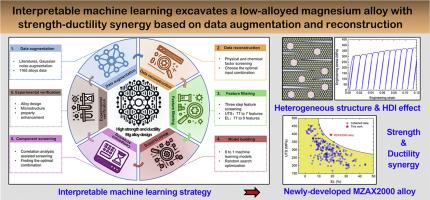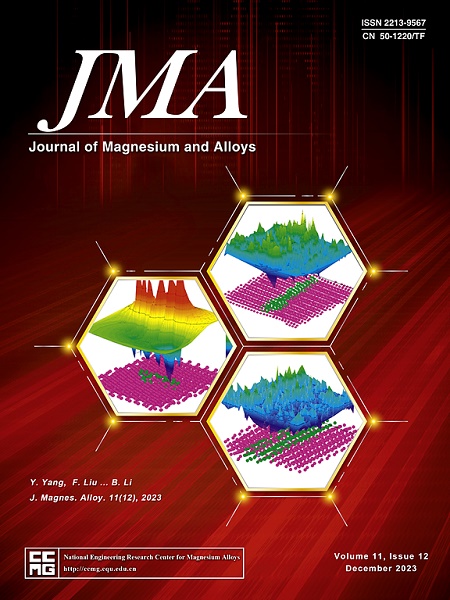Interpretable machine learning excavates a low-alloyed magnesium alloy with strength-ductility synergy based on data augmentation and reconstruction
IF 15.8
1区 材料科学
Q1 METALLURGY & METALLURGICAL ENGINEERING
引用次数: 0
Abstract
The application of machine learning in alloy design is increasingly widespread, yet traditional models still face challenges when dealing with limited datasets and complex nonlinear relationships. This work proposes an interpretable machine learning method based on data augmentation and reconstruction, excavating high-performance low-alloyed magnesium (Mg) alloys. The data augmentation technique expands the original dataset through Gaussian noise. The data reconstruction method reorganizes and transforms the original data to extract more representative features, significantly improving the model's generalization ability and prediction accuracy, with a coefficient of determination (R2) of 95.9 % for the ultimate tensile strength (UTS) model and a R2 of 95.3 % for the elongation-to-failure (EL) model. The correlation coefficient assisted screening (CCAS) method is proposed to filter low-alloyed target alloys. A new Mg-2.2Mn-0.4Zn-0.2Al-0.2Ca (MZAX2000, wt%) alloy is designed and extruded into bar at given processing parameters, achieving room-temperature strength-ductility synergy showing an excellent UTS of 395 MPa and a high EL of 17.9 %. This is closely related to its hetero-structured characteristic in the as-extruded MZAX2000 alloy consisting of coarse grains (16 %), fine grains (75 %), and fiber regions (9 %). Therefore, this work offers new insights into optimizing alloy compositions and processing parameters for attaining new high strong and ductile low-alloyed Mg alloys.

求助全文
约1分钟内获得全文
求助全文
来源期刊

Journal of Magnesium and Alloys
Engineering-Mechanics of Materials
CiteScore
20.20
自引率
14.80%
发文量
52
审稿时长
59 days
期刊介绍:
The Journal of Magnesium and Alloys serves as a global platform for both theoretical and experimental studies in magnesium science and engineering. It welcomes submissions investigating various scientific and engineering factors impacting the metallurgy, processing, microstructure, properties, and applications of magnesium and alloys. The journal covers all aspects of magnesium and alloy research, including raw materials, alloy casting, extrusion and deformation, corrosion and surface treatment, joining and machining, simulation and modeling, microstructure evolution and mechanical properties, new alloy development, magnesium-based composites, bio-materials and energy materials, applications, and recycling.
 求助内容:
求助内容: 应助结果提醒方式:
应助结果提醒方式:


